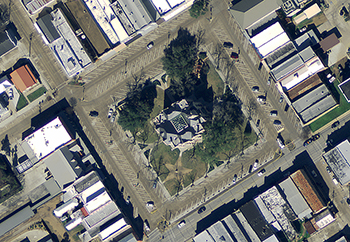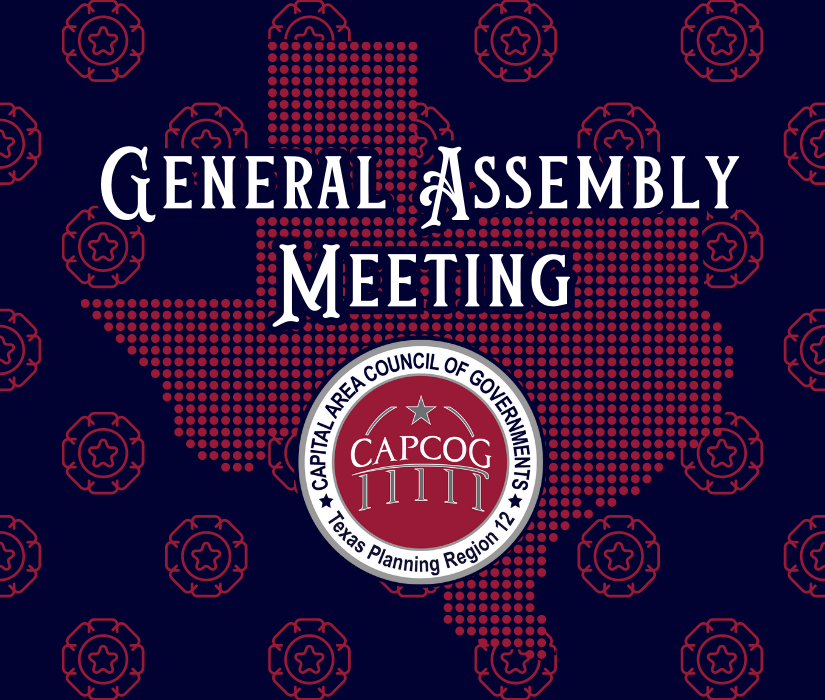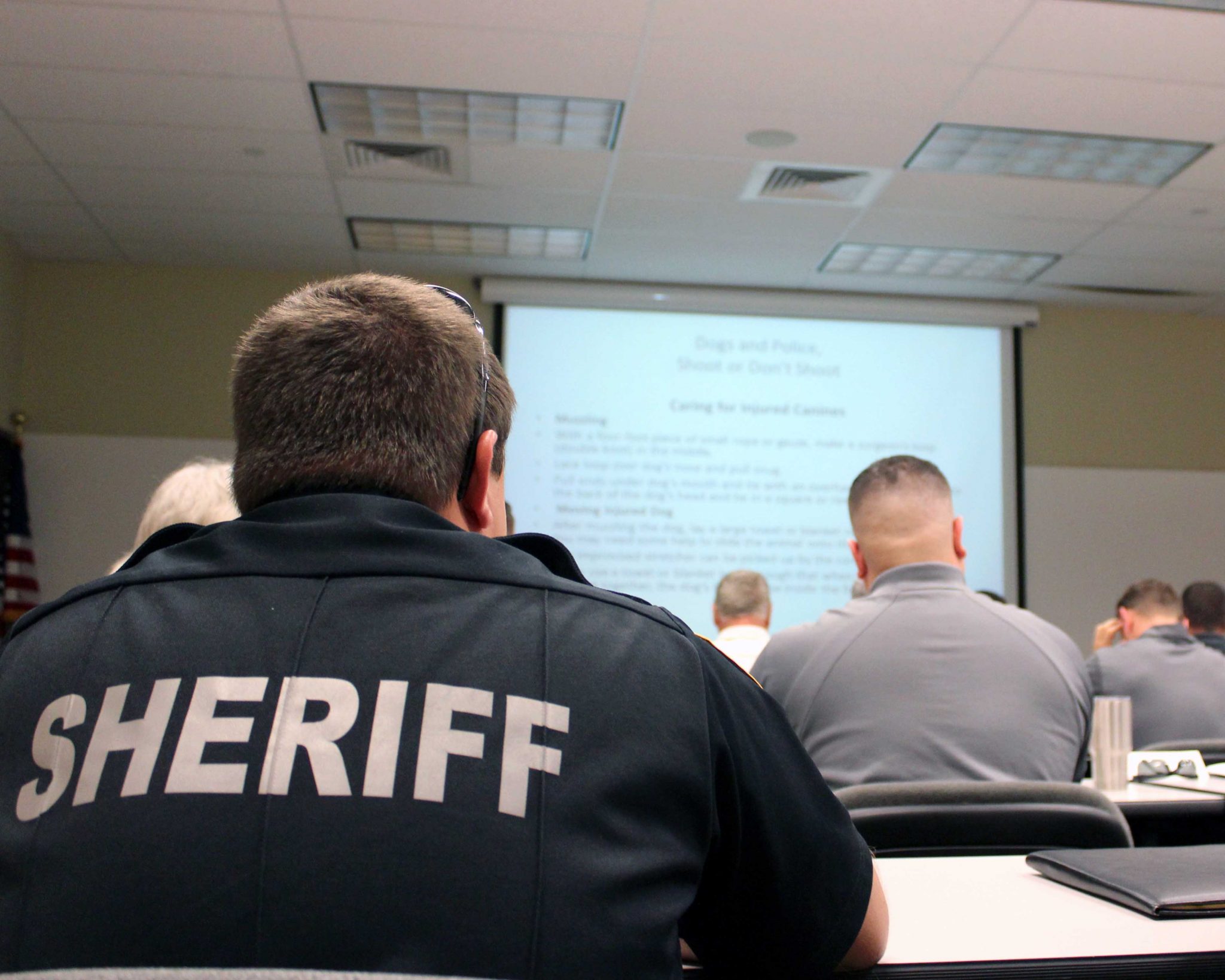- 911 Technology
- 911 Training and Public Education
- Kari's Law
- Regional Notifications System (WarnCentralTexas)
- VoIP 911
- Wireless 911
- Wireless 911 FAQ
The 9-1-1 equipment CAPCOG provides to each of its 31 Public Safety Answering Points (PSAPs) is state-of-the-art. CAPCOG provides highly trained maintenance technicians who are available 24 hours a day, 7 days a week. The equipment allows call takers to efficiently answer, process, and transfer calls to another agency if needed. CAPCOGs 9-1-1 equipment contains integrated TDD/TTY equipment to allow call-takers seamless communication with callers who are deaf, hearing impaired, or who cannot speak. In addition, we provide each PSAP with a standalone TDD device to use as a backup.
In order to respond quickly to a caller’s request for help, a 9-1-1 call taker must be able to locate the 9-1-1 caller as quickly as possible. CAPCOG employs a Mapped ALI (Automatic Location Information) solution in all 31 PSAPs. Mapped ALI automatically displays the caller’s location on a map using either the address delivered to the PSAP from the 9-1-1 database, or the GPS coordinates provided by a wireless phone or VoIP provider. In addition to the caller’s location, the maps display a broad range of information to assist the call taker with quickly locating resources, displaying known hazards, and other information. The maps also contain data on the entire CAPCOG region to enhance CAPCOG’s goal of complete interoperability in the event of a disaster.
Should a 9-1-1 call taker not speak the language of the 9-1-1 caller, CAPCOG provides each PSAP access to an interpreter service. The interpreter service can identify and communicate with the 9-1-1 caller in almost any language, and thousands of dialects, enabling the PSAP to summon the needed resources quickly. All CAPCOG 9-1-1 staff members are active in The Association of Public-Safety Communications Officials (APCO) and the National Emergency Number Association (NENA). CAPCOG is on the cutting edge of 9-1-1 technology, and is involved in many projects of both APCO and NENA regarding the future path in 9-1-1 technology.
Database Maintenance
CAPCOG provides funds to each of its 10 counties to assist with 911 database maintenance and employing a County 9-1-1 Addressing Coordinator. CAPCOG staff works with each of these coordinators to manage and update the 9-1-1 Database.
Download CAPCOG’s Addressing Guidelines.
9-1-1 & PSAP Resources
Read the CAPCOG National Public Safety Telecommunicator Week proclamation.
Emergency Telecommunicator Training
9-1-1 call-takers receive specialized training in order to handle a broad range of potential call types in the PSAP. Texas requires all call-takers to complete a 40-hour training course on basic telecommunications issues affecting PSAPs within the first year of employment. In addition, they must complete several hours of “field training” before receiving their Telecommunications Certification. The Texas Department of Public Safety also requires PSAPs performing law enforcement functions to attend 40 hours of training on the Texas and National Law Enforcement Telecommunications Systems (TLETS/NLETS). CAPCOG offers this, and additional training in: Basic Spanish, Crisis Communications, Ethics, Emergency Medical Dispatch, Emergency Fire Dispatch, Emergency Police Dispatch and more to assist the call-taker with advancing to intermediate and advanced certification levels.
In order to comply with the Americans with Disabilities Act, CAPCOG requires all call-takers to attend training on Telecommunications Device for the Deaf (TDD) within three months of employment and every six months thereafter. This training provides familiarity with the equipment, and keeps them abreast of changes in technology. Occasionally, CAPCOG offers training from various organizations such as the National Emergency Number Association (NENA) and the Association of Public-Safety Communications Officials (APCO) that specialize in issues affecting public safety.
Find emergency telecommunicator training opportunities.
Read the emergency telecommunicator training cancellation policy.
Public Education and Outreach
It is important that residents understand how to not only dial 9-1-1 but what information emergency telecommunicators need on a call. CAPCOG provides outreach and educational materials designed and developed to enhance the understanding of the 9-1-1 program. These materials are available to PSAPs and other public safety agencies throughout the CAPCOG region. The materials cover a broad range of topics associated with the proper usage of 9-1-1, wireless 9-1-1, Text to 9-1-1, and VoIP. They are available in English and Spanish.
Kari’s Law requires Texas businesses and organizations with a multiline telephone system (MLTS) or private branch exchange (PBX) to provide direct access to 9-1-1 services without callers having to first dial an outside-line prefix. The law also requires all capable systems to notify a central location on site when a 9-1-1 call is placed. Businesses, schools, hospitals and other organizations that use MLTS’s in their office are responsible for knowing and addressing compliance with the law by Sept. 1, 2016.
Achieving Compliance
In the CAPCOG 10-county region, most organizations can avoid MLTS direct access to 9-1-1 issues by working with their MLTS service provider and coordinating with their local 9-1-1 call center. By following these simples steps any organization can verify they comply or can learn how to attain compliance with Kari’s Law.
- Contact your MLTS service provider to confirm your outgoing lines can directly dial 9-1-1.
- Schedule a test call by contacting the CAPCOG Emergency Communications Division at 512-916-6004 or cmac@capcog.org. CAPCOG Emergency Communications staff can also work with you to help resolve MLTS issues.
Requesting a Waiver
If a MLTS cannot meet Kari’s Law requirements without a substantial cost, organizations can request a one-year waiver. Organizations that receive the waiver must place an instructional sticker adjacent to or on all noncompliant, outbound capable telephones instructing the user how to access 9-1-1 services. Kari’s Law has a Sept. 1, 2016 deadline for compliance and waivers must be submitted before that deadline and no later than Sept. 1 of each following year.
The Capital Area Council of Governments uses a regional notification system (RNS), WarnCentralTexas.org, as a crucial public-safety tool. The Web-based tool is available to users throughout the CAPCOG region to alert the public to emergency and non-emergency situations. It’s an effective tool for notifying a relatively large number of people in a short period of time. Messages may include content such as incident-specific information, recommended protective actions or response directives. They can be delivered to various devices that accept voice, email or SMS text content and to alpha or numeric pagers. The message sender identifies recipients, develops the message and determines which types of devices receive the message. Regional partners that use RNS can send voice messages to landline phones using CAPCOG’s 9-1-1 database. However, residents and visitors to the CAPCOG region must register their cellphone numbers and email addresses to receive notifications on mobile devices or computers.
Register today or update your information. In addition to alerts sent by local jurisdictions, residents may choose to receive automated warnings — tornado, severe thunderstorm or flash flood, for example — from the National Weather Service.
In addition to alerts sent by local jurisdictions, residents may choose to receive automated warnings — tornado, severe thunderstorm or flash flood, for example — from the National Weather Service.
Participate in public outreach
Continuing to encourage self-registrations for cellphone users plays an invaluable role in ensuring messages from WarnCentralTexas.org can reach as many people as possible. CAPCOG and its regional partners have developed materials to help promote and increase self-registration that any community or person is welcome to use. CAPCOG and it is regional partners will continually update its public outreach materials, so check back often.
Questions?
With VoIP service, telephone service including 9-1-1 service, will not be available during power outages unless the customer has special equipment. In addition, the phone will also not function if the connection to the internet is unavailable. This is important to keep in mind during an emergency, or when considering VoIP services.
Many companies around the world provide dynamic VoIP services. Dynamic VoIP service allows customers to use their phone anywhere in the world as long as they have a broadband internet connection. Special equipment is required to interface a phone with the internet. Typically, this equipment is small, lightweight, and very portable.
Dynamic VoIP’s mobility is the driving factor in its popularity. It allows people to go anywhere in the world and allows family, friends, and business associates to call the phone as a local call, thus avoiding long-distance fees. This mobility also creates challenges when dialing 9-1-1.
In a traditional phone system and Static VoIP, the phone is associated with a fixed location that does not move. New solutions to deliver the caller’s location Information had to be devised that allows the customer to update their location. In addition, the 9-1-1 infrastructure currently in place does not support this type mobility.
Today, strides have been made to overcome these problems. However, in the past, it was traditionally the phone company’s responsibility to provide the address information of a customer to the 9-1-1 database. Due to the mobility, this responsibility now lies with the customer. If the customer does not ensure that the address information on file is accurate with their VoIP provider, calls for assistance when using 9-1-1 may be delivered to a PSAP thousands of miles away.
CAPCOG continuously works with all wireless vendors to ensure reliable 9-1-1 call delivery to every PSAP in the region. Because of the mobility of wireless 9-1-1 calls, they present a special challenge to call-takers. 9-1-1 calls from wireless phones do not provide the call-takers with the caller’s name and address information automatically in the same manner as a traditional 9-1-1 call. These problems are multiplied when a 9-1-1 caller is unable to speak. A wireless subscriber’s address information is not in the 9-1-1 Database. The ability of the subscriber to take the phone anywhere hinders that data in regards to 9-1-1 calls.
There are two types of location information available to PSAPs to handle wireless 9-1-1 calls. Phase I wireless transmits the caller’s telephone number and cell-tower information to the dispatcher – this can cover several square miles. The call-taker must ascertain the caller’s location through questioning in order to obtain accurate information. Phase II wireless, which delivers the callers location with GPS coordinates in addition to Phase I data, is an enhancement to Phase I wireless. Currently, all CAPCOG PSAPs can process and utilize Wireless Phase II data.
When the call arrives at the PSAP, the caller’s location is displayed on the Mapped ALI software. This gives the call-taker a general idea of the caller’s location. Environmental and technological factors can prevent the delivery of Phase II data to the PSAP. In that case, the call-taker still has Phase I data to rely upon.
Most GPS phones have the ability to disable the location information through a menu option. This option does not apply to 9-1-1 calls, and the caller’s location information will be delivered to the PSAP regardless of this setting, if the data is available.
Text-to-9-1-1
The ability for texting emergencies to 9-1-1 PSAPs is slowly rolling out around the country, and all wireless providers were required to offer it by Dec. 31, 2014. The 31 PSAPs in CAPCOG’s 10 county region already have equipment to support text-to-9-1-1 services, and CAPCOG is the planning stages for implementing the program throughout the area. It is anticipated area PSAPs will started responding to text-to-9-1-1 reported emergencies in 2016.
As one of the primary ways people communicate with wireless phones, the ability to text emergencies to 9-1-1 can be helpful. It could be helpful if you are deaf, hard of hearing, or have a speech disability, or if a voice call might otherwise be dangerous or impossible. However, texting 9-1-1 could not automatically supply the call taker with critical information about the caller and emergency, such as a location.
Remember Call if You can, Text if You Can’t.
How common are wireless 9-1-1 calls?
As the Capital Area Emergency Communication District (CAECD) the Capital Area Council of Governments (CAPCOG) assists with managing 31 Public Safety Answering Points (PSAPs) throughout its 10-county region. Regionally, 80 percent of all 9-1-1 calls are from wireless callers. In 2014, people placed about 1.5 million 9-1-1 calls in the region, of which 1.2 million came from wireless phones.
Can my location be determined when using a wireless phone to contact 9-1-1?
All of the PSAPs overseen by the CAECD have been capable of receiving location information for wireless 9-1-1 calls since 2005. However, unlike traditional landline 9-1-1 services, that provide PSAPs the exact location of a caller, a wireless 9-1-1 call only provides an approximate location of the caller. In addition, environmental and technical factors may affect the accuracy of the location information or prevent the PSAP from receiving location information entirely.
What type of information is provided to the PSAP when I call 9-1-1 from a wireless phone?
There are two levels of location information provided to the PSAP for wireless location identification on 9-1-1 calls. Phase I Wireless provides a general area of the callers location by displaying the cellular tower from which a 9-1-1 call is originating, the general orientation (i.e. North, South, East, or West), and a callers’ telephone number. Since a cellular tower can cover a large geographical area, a PSAP may only determine a general area from where the calls originates. Phase II Wireless provides a more precise geographical location of 9-1-1 callers based on latitude and longitude. The FFC sets requirements which accuracy levels are based on today. The requirements are several years old and can affect the accuracy of the location information provided to an answering PSAP.
How is my location determined when calling 9-1-1 from a wireless phone?
Wireless providers ultimately decide how their callers’ location is determined. Today, there are two methods used to determine the location of a wireless 9-1-1 call. Check with your service provider to determine which method it uses.
Network-Based: In network-based solutions, carriers use special equipment to locate a caller by using the signals from several towers to triangulate the location of the phone. Calls from areas with a limited number of towers, such as rural areas, can lead to less accurate results and a lack of Phase II location information available to an answering PSAP.
Handset Based: In handset-based solutions, wireless carriers use a GPS chip in the handset to provide location information. The phone must be able to communicate with the GPS satellites to determine its location. Calls from indoor locations or in any environment where the phone cannot determine its location, affect the wireless provider’s ability to provide location information to an answering PSAP. Accuracy requirements for network-based solutions must be within 300 meters on 95 percent of all 9-1-1 calls and 150 meters on 66 percent of all 9-1-1 calls. Handset-based solutions must be within 50 meters on 95 percent of all 9-1-1 calls and 100 meters on 66 percent of all 9-1-1 calls. These requirements apply only to calls placed outdoors according to FCC requirements updated in 2010. According to current FCC guidelines, PSAPs are unable to determine a caller’s elevation, so if a caller is in a multi-story building that information is unavailable to a PSAP.
What information does the PSAP need when callers dial 9-1-1 from a wireless phone?
In additional to providing the nature of the emergency, callers always should be prepared to provide the address from which you are calling. If the exact location is unknown, callers should be prepared to provide other information such as cross streets or landmarks to assist PSAPs in determining their location. PSAPs also will ask to verify the telephone number from which a person is calling. Remember, although the PSAP may be able to determine your approximate location, the accuracy of that information can vary. If PSAPs are unable to retrieve a caller’s location, the information they provide can be critical to getting help in a timely fashion.
What happens if a caller is disconnected while on a 9-1-1 call?
If a caller is disconnected from a wireless 9-1-1 call, they should immediately call 9-1-1 again and let the PSAP know they were disconnected. Location information only is available to the PSAP when the phone is connected to 9-1-1. PSAPs will attempt to reconnect with a disconnected caller, but they do not receive location information when they call a wireless phone.
Is there anything being done to improve the availability and accuracy of wireless 9-1-1 calls?
In February of 2015, the FCC issued additional rules for wireless carriers to improve the availability of location information and location accuracy using technology that is more modern. The FFC based the rules, which apply to all wireless calls, on calls measured from indoor locations, inherently improving the accuracy from call placed outdoors as well. The following is an overview of the new standards and timelines for achieving them: Nationwide wireless providers shall provide location information within 50 meters, for the following percentages of wireless 9-1-1 calls within the following timeframes, measured from the effective date of the adoption of this rule:
- Within 2 years: 40 percent of all wireless 9-1-1 calls.
- Within 3 years: 50 percent of all wireless 9-1-1 calls.
- Within 5 years: 70 percent of all wireless 9-1-1 calls.
- Within 6 years: 80 percent of all wireless 9-1-1 calls.
Vertical location: Wireless providers shall provide vertical location information with wireless 9-1-1 calls as described in this section, within the following timeframes, measured from the effective date of the adoption of this rule: Within 6 years each of the top 25 Commercial Wireless Markets (CMA), nationwide wireless providers shall deploy either a dispatchable location, or a z-axis technology in compliance with any z-axis accuracy metric that has been approved by the FCC. Within 8 years each of the top 50 CMAs, nationwide wireless providers shall deploy either a dispatchable location or a z-axis technology in compliance with any z-axis accuracy metric that has been approved by the FCC – the 10-county CAPCOG region is in this category. Non-nationwide wireless providers that serve any of the top 25 or 50 CMAs will have an additional year to meet each of these benchmarks.









































































